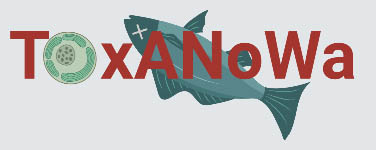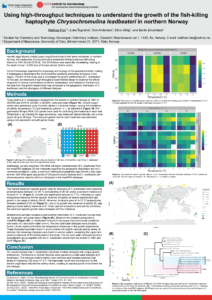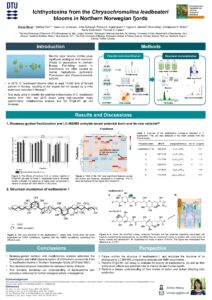— Uncovering fish-killing mechanisms of phytoplankton from Scandinavian waters

Researchers currently observe an increase in the frequency, severity and geographic distribution of harmful algal blooms all over the world. Scandinavia is no exception, and the recent toxic algal bloom in Northern Norway during spring 2019 was disastrous for the aquaculture industry resulting in total lost production of about 40,000 tons of salmon, equating to financial losses estimated at around NOK 2.2 billion (USD 225 million).
Despite the regular and worldwide occurrence of fish-killing algal blooms, the exact mode-of-action of many relevant species remains unclear. The ToxANoWa project aims to obtain a comprehensive understanding of the fish-killing activity and mechanisms of selected and relevant bloom-forming species from Scandinavian coastal waters, and to identify climatic and anthropogenic factors that affect toxicity. By combining a suite of bioassays with state-of-the-art chemical profiling and analyses we will identify potentially toxic compounds in algal cultures and a field sample from the 2019 algal bloom in Northern Norway. One of the few types of algal toxins that is known for their fish-killing toxicity are the prymnesins. This class of toxins will receive special attention, and we wish to study their structural diversity and toxicity in Scandinavian algal strains in detail. The ToxANoWa project will also result in technological advancements, and for the first time provide the scientific community with prymnesin reference standards and antibodies for future worldwide monitoring efforts.
The overall objective is to obtain a comprehensive understanding of the fish-killing activity and mechanisms of selected and relevant HAB-forming species from Scandinavian coastal waters, and to identify climatic and anthropogenic factors that affect toxicity.
The specific objectives are:
- Identify suitable bioassays to detect toxic activity in haptophytes relevant to Scandinavia
- Study the effects of environmental conditions on algal growth rate and toxicity in vitro
- Identify potentially toxic compounds in relevant algal cultures and a C. leadbeateri field sample including state-of-the-art metabolomics profiling and statistical modelling
- Apply a newly established salmon epithelial gill cell line in addition to a well-established rainbow trout epithelial gill cell line for in-depth toxicity studies of ichthyotoxins
- Clarify the production and structural variability of ichthyotoxic prymnesins in Scandinavian species and strains of Prymnesiales
- Purify selected major prymnesins and produce analytical reference standards and make them available to the scientific community
- Prepare and characterise polyclonal antibodies that can be utilised as immunochemical tools for toxin extraction and detection
ToxANoWa is a four year project (2021-2025) supported by the Norwegian Research Council (NFR #314861). The project is a collaboration between the Norwegian Veterinary Institute, University of Oslo, the Technical University of Denmark and the National Research Council of Canada.
| Project participants at NVI: | Project participants at UiO: | Project participants at DTU in Denmark: | Project participants at NRC in Canada: |
| Ingunn Anita Samdal (project leader) Mathias Fon (PhD student) Silvio Uhlig (former project leader) Anita Solhaug Oscar Daniel Rangel-Huerta Christopher O. Miles (2023-) Dorothea Gilbert | Bente Edvardsen Tom Andersen | Thomas Ostenfeld Larsen Xinhui Wang | Beth Mudge Christopher O. Miles (2021-2023) Pearse McCarron |
Publications
- Fon M, Chen A, Ghesquière R, Uhlig S,Edvardsen B and Anita Solhaug. The cytotoxicity of the haptophyte Chrysochromulina leadbeateri towards the Atlantic salmon gill cell line ASG-10. Harmful Algae 2025,142:102797.
- Fon M, Šupraha L, Andersen T, Uhlig S and Edvardsen B. Optimal growth conditions of the haptophyte Chrysochromulina leadbeateri causing massive fish mortality in Northern Norway. Harmful Algae 2024,139:102709.
- Wang X, Fon M, Andersen AJC, Solhaug A, Ingebrigtsen RA, Samdal IA, Uhlig S, Miles CO, Edvardsen B and Larsen TO. Insights into the nature of ichthyotoxins from the Chrysochromulina leadbeateri blooms in Northern Norwegian fjords. Harmful Algae 2024, 137, 102681.
- Bannon CC, Wang X, Uhlig S, Samdal IA, Mccarron P, Larsen TO and Mudge EM. 2024. Influence of biotic and abiotic factors on prymnesin profiles in three strains of Prymnesium parvum. Algal Research 2024, 78, 103390.
- Uwe J, Šupraha L, Gran-Stadniczeñko S, Bunse C, Cembella A, Eikrem W, Janouškovec J, Klemm K, Kühne N, Naustvoll L, Voss D, Wohlrab S and Edvardsen B. Spatial and biological oceanographic insights into the massive fish-killing bloom of the haptophyte Chrysochromulina leadbeateri in northern Norway. Harmful Algae 2022, 118, 102287.
PhD thesis
- Fon, Mathias: Insight into the growth, toxicity and toxins of the fish-killing haptophyte Chrysochromulina leadbeateri. University of Oslo, 2025.
Master theses
- De Meyst, Lise: Characterization of B-type prymnesins for improved purification, handling and stability. Ghent University, 2024.
- Reitzel, Helene: The ichthyotoxic algae Chrysochromulina leadbeateri – an investigation into favorable conditions for growth and toxicity. . Universitetet i Oslo 2023.
- Røsbak, Silje K.: Mikrobielt samfunn i kulturer av Chrysochromulina leadbeateri og relaterte svepeflagellater undersøkt med metastrekkoding. Universitetet i Oslo 2023.
- Tran, Jacquelynn Phuong-Vy: When hungry meets harmful: investigating the toxic relationship between haptophytes and copepods. Predatory induced defenses in Chrysochromulina leadbeateri. Universitetet i Oslo 2023.
- Rosalie Ghesquiére: Evaluating toxicity of the living algae Chrysochromulina leadbeateri on the Atlantic salmon gill cell line ASG-10. Ghent University, 2023.
- Laura Beeckman: Bioassay-guided fractionation of extracts from cultures of the fish-killing haptophyte Chrysochromulina leadbeateri. Ghent University, 2022
- An Chen: Evaluation of Chrysochromulina leadbeatri toxicity on ASG-10 cells. Ghent University, 2022.
Posters



